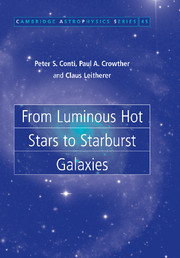Book contents
- Frontmatter
- Contents
- Preface
- Acknowledgements
- 1 Introduction
- 2 Observed properties
- 3 Stellar atmospheres
- 4 Stellar winds
- 5 Evolution of single stars
- 6 Binaries
- 7 Birth of massive stars and star clusters
- 8 The interstellar environment
- 9 From giant HII regions to HII galaxies
- 10 Starburst phenomena
- 11 Cosmological implications
- References
- Acronyms
- Symbols
- Object index
- Subject index
7 - Birth of massive stars and star clusters
Published online by Cambridge University Press: 28 October 2009
- Frontmatter
- Contents
- Preface
- Acknowledgements
- 1 Introduction
- 2 Observed properties
- 3 Stellar atmospheres
- 4 Stellar winds
- 5 Evolution of single stars
- 6 Binaries
- 7 Birth of massive stars and star clusters
- 8 The interstellar environment
- 9 From giant HII regions to HII galaxies
- 10 Starburst phenomena
- 11 Cosmological implications
- References
- Acronyms
- Symbols
- Object index
- Subject index
Summary
Massive stars are born in interstellar clouds made up of molecular gas and dusty material. Most of these stars originate from GMCs with typically ∼105M⊙. Upon collapse, these lead to massive star clusters. Some massive stars are born separate from these massive concentrations of gas and dust in smaller clouds and end up in more compact star clusters. Truly isolated massive stars seem to be rare in our Galaxy. Indeed, de Wit et al. (2005) argue that only a few percent of massive stars are born away from clusters. All these massive stars are found highly concentrated towards the Galactic plane where current star formation is still proceeding, albeit at a relatively restrained rate at present.
Consider first an individual massive star. It is formed when gravitational instability overwhelms a cloudlet of gas and dust which then begins a process of collapse. The collapse brings more and more material to the central object in a process of heating and rapid accretion. This phase is very rapid and will only be observed at far-IR wavelengths as the central material aggregates, begins to heat up, and emits radiation or molecular emission at radio wavelengths. Very quickly sufficient material accumulates such that an individual object can be identified. As this material continues to heat from the continuous contraction and accretion of more gas and dust it takes on the characteristic of what is called a “hot core”, radiating also now at mid-IR wavelengths.
- Type
- Chapter
- Information
- From Luminous Hot Stars to Starburst Galaxies , pp. 154 - 179Publisher: Cambridge University PressPrint publication year: 2008



